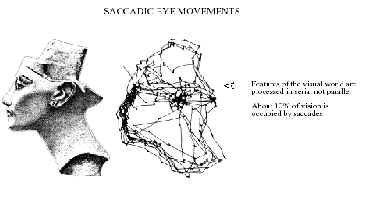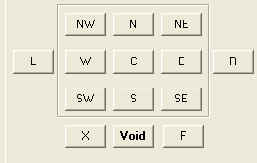Inkha Vision Software
motion-based tracking
bob mottram provided free vb code that tracks moving objects
his code was expanded upon and rejigged for our purposes
thresholds
when the value of a certain parameter is exceeded an event occurs
once a certain parameter exceeds a threshold then activity or an action occurs
example:
the x position of the centre of motion creates lies in the e sector
the activity is sufficient to frighten inkha
the value of a certain number of pixels in the foveal region is deemed ‘red' (rgb only)
nature
the activity of the human eye has been
intensively studied and modelled
humans use saccades for rapid scanning, moving a small area of high resolution rapidly
around a visual scene
a map of the saccadic movements of the eyes examining an image

dr daniel barth, mammalian neurophysiology, sensorimotor system ii: posture
this has been modelled:

s f zornetzer, joel l davis, c lau (eds), an intro to neural and electronic networks, academic press inc, p195
the purpose of these movements is to bring images of particular areas of the visual world to fall onto the fovea, saccades are
therefore a major instrument of selective visual attention
rapid movement of the eyes and a slower head movement constitute a saccade
since the eyes are already on the target as the head moves, a compensatory movement of the eyes relative to the head is required to keep the eyes on the target the vestibular-occular reflex (vor) (which uses the ears’ semi-circular canals to monitor head accelerations) is shut off for saccades of 40 degrees or more
the net result of this is constancy of gaze
the concept of colour, the concept of a ‘shirt’
the foveal region is used for colour analysis
using rgb:
initial analysis of what constitutes typical ‘red’ was undertaken using thresholds
typically ‘red’, ‘green’or ‘blue’ have an rgb value of
80% its ‘own’ colour
and less than 30% those of the other two colours
black was defined as having all rgb values below 30%
white all rgb values above 80%
the colour is then used to produce a verbal comment using the speech module
it was soon noticed that the lighting levels and the camera compensation for this made dynamic alteration of these percentage values very desirable
using hsl:
the hue is used to negate the problem of low light level
hue is used in two ways (selected in behavioural
module): density and average
the density check-box creates a count of the instances of the
integer values of hue (0 -359), the most frequent hue being selected
the average check-box is the average of the hues
the hue/colour that is seen is then compared to a colour database entry
inkha then issues a verbal comment via the speech module
what is a 'shirt'?
initial qualitative experiments determined that activity centred on faces and large areas of colour
further analysis defined the shirt concept as: "the requirement to occupy 10% of the foveal region"
vector production
to move inkha the sensing system had to provide appropriate vectors to initiate tracking movement
it was decided that the following vectors would be used: n, nw, w, sw, s, se, e and c
these are produced by processing the camera output
the l and r vectors will come from the ‘ears’ (pirs)

here is a screenshot of the vectors’relationship to each other
the division of the visual region into a grid will produce these vectors
the boundaries of the sectors will be dynamically alterable, allows flexibility to tune tracking to the idiosyncrasies of the motors or mechanics
to achieve lifelike behaviour the following vectors would be required: x, void and f
these vectors are produced via the processing of the camera output
they are used to create behaviours
if the activity is not sufficiently high then a nothing of interest, noi, or void vector is produced, should the visual stimulus be intriguing then an x is produced and if the
activity is large then the f vector will indicate a frightening situation
this is analogous to the concept of the affordance of size: detection of a large creatures may cause the viewer to
consider ‘flight’, whereas a smaller object may initialise the ‘feed’ behaviour